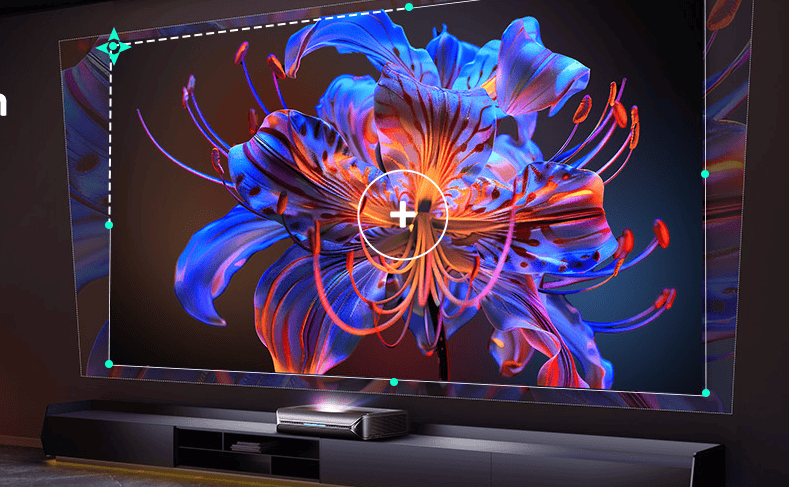
The UST Triple Laser TV Projector: Unveiling What Sets It Apart
Dive deep into the world of the UST Triple Laser TV Projector, exploring its unique features, market potential, and how leading brands are currently performing in this competitive landscape.
Armas L.
Armas L.
E-commerce seller by day, weekend writer by passion - and proud part-time content partner with Keble! Total tech geek who lives for the latest fashion drops. Currently obsessed with streamlining my workflow (and helping others do the same). If you're not using Keble yet, you're seriously missing out! Been creating guides and tips for the Keble community and loving every minute of it
In a world where home entertainment continues to evolve, the emergence of the UST Triple Laser TV Projector is making waves. This isn't just another projector on the shelf; it's a revolution that has left many industry players scrambling to catch up. With an exceptional ability to project a massive image from just inches away, you might wonder: what makes this product stand apart? And how is it weathering the competitive storm in the larger projector market? Today, we dig deep to uncover the hidden stories of this groundbreaking device and the market dynamics at play.
What if everything you believed about succeeding on Amazon was wrong? The tech revolution has spread its wings, and the UST Triple Laser TV Projector is challenging everything in the home entertainment space.
In a crowded market filled with traditional projectors, this device doesn't just compete—it sets a new standard. What is it?
The UST Triple Laser TV Projector is a cutting-edge ultra-short throw (UST) projector designed to deliver high-quality visuals from mere inches away from the wall. Unlike traditional projectors that require significant distance for a clear image, the UST projector shines brilliantly from close range, allowing for easy setup in small spaces. Its triple-laser technology promises vibrant colors and incredible brightness, revolutionizing movie nights and gaming sessions.
But here's what they don't want you to know: traditional projectors are lagging behind, needing vast distances and complicated setups—the UST is effortless by comparison.
Specifications:
- Resolution: Up to 4K UHD
- Brightness: Over 3000 lumens
- Throw Distance: Just inches from the wall
- Smart Integration: Works seamlessly with smart TVs and devices
So, how does the market stack up? In recent months, the projector market has seen staggering growth, with an estimated average monthly revenue of $55403.74 across select products. The UST projector category is emerging as a key player, boasting competitive averages and capturing the attention of niche customers.
Market Dynamics:
In 2024, we saw only 3 new releases enter the UST projector segment, reflecting a cautious yet strategic approach from established brands. Competition is fierce, but innovators are carving out significant shares. Top names like AWOL VISION have made strides, showing monthly revenues of over $153,402.50, and profits around $88,758.69. In a world where many brands are failing to make an impact, emerging technologies like the UST projector open a door where a solid investment could yield high returns.
Meanwhile, established brands suffer from an oversaturated market—it’s a battlefield with competitors risking their investments, as shown by those brands spending $50,000 only to falter due to lack of differentiation.
What’s next? In our upcoming sections, we’ll dissect the financial metrics that could save investors from common pitfalls. We will look at the performance of current players, revealing who's thriving and who’s falling flat. Get ready to uncover the secrets to success and what truly lies behind the numbers in the projector market!



What if everything you believed about succeeding on Amazon was wrong? What if the next big hit in home entertainment was just sitting in a sea of competition, waiting for the right moment to shine?
The UST Triple Laser TV Projector is not just another gadget; it's a beacon of innovation that promises to reshape the projector landscape. But here’s the kicker: the market for home projectors is expanding rapidly, presenting both an opportunity and a trap for the unwary.
The Revenue Landscape
Last month alone, the projector market generated approximately $55,403.74 in identifiable revenue from a select 21 products. It’s a healthy snapshot, but it’s not the whole story. Think about it—most of these revenues come from established brands that have built their reputations over years. The UST Triple Laser, however, sits in a volatile segment.
Growth Potential
The emerging trend shows nothing but potential if you know how to navigate it. However, the question looms: with established players like Epson and Formovie in the game, how does a newcomer even think about breaking through? The reality throws down a gauntlet; less than 1 in 10 new releases by established brands show profitability. When you dissect recent product releases, it's alarming. There are no profitable releases from both Formovie and Epson in the last three years directly correlating with their latest entries into this category. The competitors need serious R&D to keep their edge.
The Stakes of Innovation
Innovation is critical, yet the latest data reveals a disconcerting truth: the majority of these new products are underperforming. In fact, 100% of Formovie’s new releases were marked as non-profitable! That's right—new products from old brands aren’t keeping pace. Meanwhile, competitors like AWOL VISION hold a staggering 66.67% of non-profitable releases, haunting the newcomers with stark benchmarks.
The Investment Dilemma
Investing in this market? It won’t come cheap. The average budget needed for entering products stands shy of your budget constraints—you only have $13,000. To compete effectively with industry giants or to merely carve out a niche for products like the UST Triple Laser TV, you'd need considerably more backing to cover sourcing, logistics, and marketing costs.
Profit Ratios and Industry Saturation
Looking at the figures, if you’re aiming for profit margins under 40%, you might be setting yourself up for disappointment. The natural distribution reflects this reality: every other month, the profit margin dips below expectations, leaving few genuine growth opportunities in their wake. Ultimately, understanding where you stand in terms of profitability against overwhelming competitors distills the truth: if you don’t innovate, you stagnate.
Conclusion
To sum it all up: this is a ticking clock on whether the UST Triple Laser TV will rise to glory or languish in the shadows of non-profitability. Newcomers need to be especially cautious, for the ground is littered with poacher traps and underperformers—many brands fall, yet few succeed. The lesson? put your chips on innovation, or get ready to be outpaced.
Stay tuned as we peel back more insights from the competitive digital marketplace, revealing which brands are succeeding and which are destined to be relegated to failure in the year to come.



